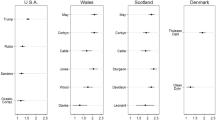Abstract
The American public expresses considerable consensus on those qualities of character and performance indispensable to a modern president. Contrary to expectations, however, such conceptions of an ideal president (or presidential prototypes) generally failed to provide standards by which actual presidential candidates were evaluated. Across five complementary tests, qualities that citizens thought important for an ideal president counted no more heavily in their evaluations of presidential hopefuls than did qualities thought less important—with one consistent and striking exception. Conceptions of an ideal president did set the standards by which the incumbent president was evaluated, and quite powerfully so. In the final section of the paper, we provide several interpretations of these results, suggest how public conceptions of an ideal president are acquired, and speculate about processes of presidential appraisal.
Similar content being viewed by others
References
Barber, J. D. (1971). “The Presidency: What Americans Want.”The Center Magazine, Jan./Feb. 2–6.
Brody, R. A. (1980). “Public Evaluations and Expectations and the Future of the Presidency.” Manuscript, Stanford University.
Brody, R. A., and B. I. Page (1975). “The Impact of Events on Presidential Popularity: The Johnson and Nixon Administrations.” In A. Wildavsky (Ed.),Perspectives on the Presidency. Boston: Little Brown.
Cantor, N., and W. Mischel (1979). “Categorization Processes in the Perception of People.” In L. Berkowitz (Ed.),Advances in Experimental Social Psychology, Vol. 12. New York: Academic Press.
Cronin, T. (1974) “The Textbook Presidency and Political Science.” In S. Bach and G. T. Sulzner (Eds.),Perspectives on the Presidency. Lexington, MA: Heath.
Dawes, R. M. (1976). “Shallow Psychology.” In J.S. Carroll and J. W. Payne (Eds.),Cognition and Social Behavior. Hillsdale, NJ: Erlbaum.
Downs, A. (1957).An Economic Theory of Democracy. New York: Harper.
Edelman, M. (1964).The Symbolic Uses of Politics. Urbana, IL: University of Illinois Press.
Fiorina, M. P. (1981).Retrospective Voting in American National Elections. New Haven: Yale University Press.
Gans, H. J. (1979).Deciding What's News. New York: Pantheon.
Greenstein, F. I. (1978). “Change and Continuity in the Modern Presidency.” In A. King (Ed.),The New American Political System. Washington, D.C.: American Enterprise Institute.
Heclo, H. (1977).Studying the Presidency. Report to the Ford Foundation.
Hodgson, G. (1980).All Things to All Men. New York: Simon & Schuster.
Kagay, M. R., and G. A. Caldeira (1975). “I like the Looks of His Face: Elements of Electoral Choice, 1952–1972.” Delivered at the Annual Meeting of the American Political Science Association, San Francisco, CA.
Kernell, S. (1978). “Explaining Presidential Popularity.”American Political Science Review, 72:506–522.
Key, V. O., Jr. (1966).The Responsible Electorate. Cambridge: Harvard University Press.
Kinder, D. R. (1981). “Presidents, Prosperity, and Public Opinion.”Public Opinion Quarterly, in press.
Kinder, D. R., R. P. Abelson, and S. T. Fiske (1979).Developmental Research on Candidate Instrumentation: Results and Recommendations. Report available from Center for Political Studies, ISR, The University of Michigan.
Kinder, D. R., R. P. Abelson, S. T. Fiske, and M. D. Peters (1979). “Impressions of Political Leaders.” Paper prepared for 87th Annual Meeting of the American Psychological Association.
Kinder, D. R., and D. R. Kiewiet (1979). “Economic Discontents and Political Behavior: The Role of Personal Grievances and Collective Economic Judgments in Congressional Voting.”American Journal of Political Science, 23:495–527.
Kinder, D. R., and D. R. Kiewiet. “Sociotropic Politics.”British Journal of Political Science, In press.
Kramer, G. H. (1971). “Short-term Fluctuations in U.S. Voting Behavior, 1896–1964.”American Political Science Review, 65:131–143.
Kumar, M. J., and M. B. Grossman (1980). “Images of the White House in the Media.” Presented at the Annual Meeting of the American Political Science Association, Washington, D.C.
Miller, A. H., and W. E. Miller (1976). “Ideology in the 1972 Election: Myth or Reality.”American Political Science Review, 70:832–849.
Miller, A. H., and W. E. Miller (1977). “Partisanship and Performance: ‘Rational’ Choice in the 1976 Presidential Election.” Presented at the Annual Meeting of the American Political Science Association.
Monroe, K. R. (1979). “Econometric Analysis of Electoral Behavior: A Critical Review.”Political Behavior, 1:137–174.
Mueller, J. E. (1970). “Presidential Popularity from Truman to Johnson.”American Political Science Review, 64:18–34.
Nimmo, D., M. Mansfield, and J. Curry (1978). “Persistence and Change in Candidate Images.” in G. F. Bishop, R. G. Meadow, and M. Jackson-Beck (Eds.),The Presidential Debates. New York: Praeger.
Nimmo, D., and R. L. Savage (1976).Candidates and their Images. Pacific Palisades, CA: Goodyear.
Nisbett, R. E., and T. D. Wilson (1977). “Telling More Than We Can Know: Verbal Reports on Mental Processes.”Psychological Review, 84:231–259.
Page, B. I. (1978).Choices and Echoes in Presidential Elections. Chicago: University of Chicago Press.
Sears, D. O. (1975). “Political Socialization.” In F. I. Greenstein and N. Polsby (Eds.),Handbook of Political Science, Vol. 2. Reading, MA: Addison-Wesley.
Sigel, R. S. (1966). “Image of the American Presidency.”Midwest Journal of Political Science 10:123–137.
Smith, E. R., and F. D. Miller (1978). “Limits on Perception of Cognitive Processes: A Reply to Nisbett and Wilson.”Psychological Review, 85:355–362.
Taylor, S. E., and J. Crocker (1981). “Schematic Bases of Social Information Processing.” In E. T. Higgens, C. A. Herman, and M. P. Zanna (Eds.)Social Cognition. Hillsdale, NJ: Erlbaum.
Tufte, E. R. (1978).Political Control of the Economy. Princeton: Princeton University Press.
Wayne, S. J. (1980). “Expectations of the President.” Presented at the Annual Meeting of the American Political Science Association, Washington, DC.
Author information
Authors and Affiliations
Rights and permissions
About this article
Cite this article
Kinder, D.R., Peters, M.D., Abelson, R.P. et al. Presidential prototypes. Polit Behav 2, 315–337 (1980). https://doi.org/10.1007/BF00990172
Issue Date:
DOI: https://doi.org/10.1007/BF00990172




